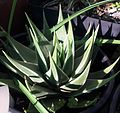| Tulista | |
|---|---|
 | |
| Tulista marginata | |
| Scientific classification | |
| Kingdom: | Plantae |
| Clade: | Tracheophytes |
| Clade: | Angiosperms |
| Clade: | Monocots |
| Order: | Asparagales |
| Family: | Asphodelaceae |
| Subfamily: | Asphodeloideae |
| Tribe: | Aloeae |
| Genus: | Tulista Raf. |
| Synonyms | |
Tulista is a small genus of succulent plants endemic to the Cape Provinces of South Africa. [1] They were formerly included within the genus Haworthia .















